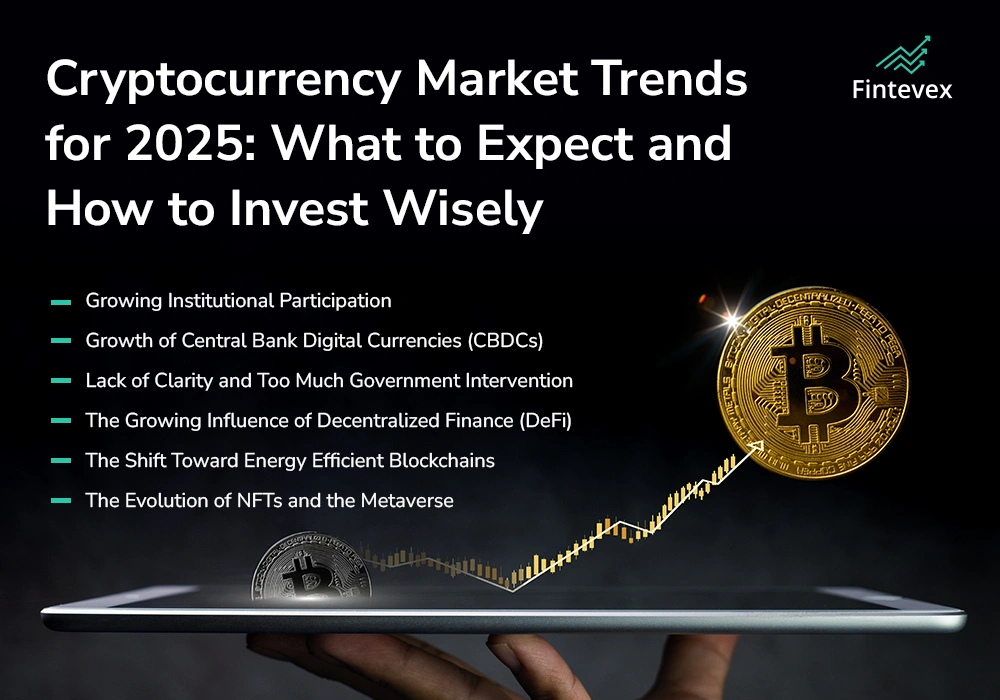In the past few years, the cryptocurrency market has remained one of the most volatile yet promising financial sectors. There is the rise of Bitcoin as a form of digital gold, followed by the expansion of decentralized finance (DeFi) and non-fungible tokens (NFTs). The industry is continually improving. Now, in 2025, there are new trends and innovations which stealthily change the market, providing both opportunities and threats for investment.
In order to work with digital assets successfully, one has to pay special attention to indicators that seem arbitrary, but can greatly impact investment, both positively and negatively. This article aims to identify key trends in the cryptocurrency market for 2025, what challenges they might bring in, and how it may impact investment decisions.

What Leads to Changes in Cryptocurrency Trends
Ever since the launch of Bitcoin back in 2009, the cryptocurrency market has made significant strides. Throughout the years crypto assets have transformed from speculative instruments, and are now key players in the realms of payment, and even decentralized finance digital identity solutions.
In 2025, the market underwent heightened institutional investment, greater regulatory transparency, and superior blockchain infrastructure. These improvements greatly aided the cryptocurrency market, and while it still operates on the basis of volatility, investors now have the ability to adapt to new forms, and stay informed.
Important Cryptocurrency Market Developments in 2025
- Growing Institutional Participation
Possibly the most striking trends noted in the crypto market in 2025 are the digital assets adoption by institutional investors. International banks, hedge funds, and publicly listed companies are starting to purchase cryptocurrencies.
An increasing number of companies are now incorporating Bitcoin in their treasury reserves as a defense mechanism to inflation.
Investment banks and asset management companies are offering crypto related financial instruments, including Bitcoin multiple ETFs and blockchain based securities.
Partnerships between traditional financial institutions and blockchain companies to build crypto custody and trading services are being developed.
The involvement of institutions is likely to bring more order to the market and enhance liquidity, which makes investing in cryptocurrencies more appealing for larger investors.
- Growth of Central Bank Digital Currencies (CBDCs)
Numerous governments across the globe are looking into or implementing, out of need, forms of digital currencies at a national level in order to compete with existing cryptocurrencies. Central Bank Digital Currencies (CBDCs) are blockchain enabled tokens that represent value issued by a country’s government or its central bank.
China, the European Union, and the USA are advancing their respective CDBC initiatives.
CBDCs can improve payment efficiency, enhance the speed of transactions, and reduce overall monetary expenditure as well as increase inclusion in certain economic activities.
While CBDCs stand a chance of legitimizing digital currencies, the extent to which government surveillance and privacy invasion will be made is still worrying.
As CBDCs start to rise in popularity, their adoption could severely affect decentralized cryptocurrencies such as Bitcoin and Ethereum.
- Lack of Clarity and Too Much Government Intervention
From the very start, regulation has posed challenges in the crypto space with governments trying to find the sweet spot that fosters innovation while protecting investors. In 2025, a growing number of nations will be adopting explicit policies concerning the regulation of cryptocurrencies.
The SEC in the U.S. and other regulators in different parts of the world are building a legal framework around the notion of crypto assets.
Strict compliance to the Know Your Customer (KYC) legislation and Anti-Money Laundering (AML) provisions has become compulsory for crypto exchanges.
UAE and Singapore are among countries with lenient legislation which are becoming business and investment hot spots for cryptocurrency enthusiasts.
Although overly regulation is welcomed for the credibility of the crypto space, it may not be welcomed for specific projects, in turn, avoiding drastic changes in the market.
- The Growing Influence of Decentralized Finance (DeFi)
Decentralized Finance (DeFi) remains one of the most rapidly expanding areas of the cryptocurrency industry and has not slowed down to this date. With DeFi platforms Intermediaries are removed and users can utilize financial services like borrowing, minting, and trading.
DeFi applications are incorporating sophisticated smart contracts to deliver more security and improved performance.
Decentralized insurance policies or synthetic assets are just some of the new financial products being created.
The DeFi space is now getting the attention of institutional investors, which means more money and a good reputation for the industry.
This shift from progressive finance to DeFi also serves as a substitute for traditional banking and has the potential to upend the entire financial industry.
- The Shift Toward Energy Efficient Blockchains
With the growing concern on Bitcoin’s proof-of-work mining process, sustainability is a huge talking point in the cryptocurrency sector. In 2025, the attention will be on energy-efficient blockchain networks.
The cut-down in energy consumption brought by Ethereum’s switch to proof-of-stake during its transition has encouraged other projects to do the same.
Environmental friendliness and scalability are the main features of upcoming blockchains like Solana and Avalanche.
Various businesses and corporations are pushing towards carbon-neutral and green blockchain initiatives for sustainable reasons.
The crypto investments’ environmental impacts are getting more attention from investors, resulting in increased funding towards projects with sustainable blockchains.
- The Evolution of NFTs and the Metaverse
Non-fungible tokens have advanced from just digital arts and collectibles to gaming, real estate, and even intellectual property rights.
Various big brands and companies are integrating NFTs into their business ventures by creating digital assets, which gives them access to the NFT space.The virtual pieces of land on metaverse platforms such as Decentraland and The Sandbox are increasing in value.
Industries such as ticketing, music royalties, and content ownership are expanding further by integrating technology through NFTs, which were previously focused solely on finance.
With the improvement of blockchain technology, it is highly likely that NFTs will become a core part of the digital economy. Like any other form of investment, investing in cryptocurrency in 2025 will require strategizing and careful execution.

How to Invest in Cryptocurrencies in 2025
Given the evolving landscape, investing in cryptocurrencies requires careful planning and risk management. Here are some key strategies to consider:
Diversify Your Portfolio
Instead of investing in a single cryptocurrency, consider diversifying across different assets such as Bitcoin, Ethereum, DeFi tokens, and metaverse projects.
Stay Informed About Regulations
Monitor global regulatory developments, as government policies can significantly impact the market. Choosing exchanges and wallets that comply with regulations can reduce risks.
Focus on Long-Term Value
While short-term trading can be profitable, long-term investments in fundamentally strong projects often yield better returns. Look for cryptocurrencies with real-world use cases and strong developer communities.
Secure Your Investments
With increasing cyber threats, securing your assets is crucial. Use hardware wallets, enable two-factor authentication, and avoid storing large amounts of crypto on exchanges.
Assess Market Trends Before Investing
Analyzing macroeconomic trends, institutional adoption, and technological advancements can help you make more informed investment decisions. Following industry news and expert insights is essential.
Final Thoughts:
Investors should look out for any shifts in the cryptocurrency market, especially upto the year 2025 with the massive growth in institutional adoption, clear regulations and development in technology. Even though there is an appeal due to volatility and uncertain regulations, investors will still have options to delve into.
In order to position themselves for long-term success, investors will need to prune themselves to key trends de Fi expansion, sustainability or the NFT craze. Use the words of wisdom whether you are strategic in your investments or entry-level within the crypto realm as it will help fortify your position in the dense, innovative world of digital assets.

















